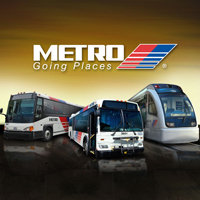Proof of concept for now and contingent on a competitive federal grant, but hopefully the start of something bigger.
Transit officials in the self-proclaimed energy capital of the world are recharging their attempts to wean Metro off fossil fuels.
Metropolitan Transit Authority officials, sensing both the technology and federal interest in funding are ripe, are preparing to buy up to 20 all-electric buses that would operate along two routes.
Though Metro has tried and failed to find an electric bus that can handle the hot Houston summer in the past, officials said they are growing more optimistic newer batteries have the necessary juice to keep the vehicles moving and riders cool.
Fears the region may not have much time before drastic action is needed to mitigate climate change with lower vehicle emissions, are prompting Metro to move faster on flipping the switch on its fleet, albeit gradually.
“Some of the recent weather events have made this a more urgent matter,” said Kimberly Williams, chief innovation officer for Metro, referring to the increasing frequency of major hurricanes along the Gulf Coast and flooding in the Houston area.
In addition to buying zero-emission buses, Metro officials also are forming a task force, led by board member and former Harris County Clerk Chris Hollins, aimed at modernizing Metro’s operations to meet local climate change goals.
The changes for Metro are likely to vary in scope and size. Some, such as replacing lighting with more energy efficient LED options, already are underway. Others, such as encouraging more transit use and less solo car and truck trips by travelers by offering more convenient bus routes or adding bus rapid transit lines, are included in the agency’s long-range plans.
[…]
The viability of the vehicles, however, remains uncertain. That is why Metro officials — who manage about 1,200 buses — plan to start with 20. Previous attempts to test electric buses in Houston did not lead to purchasing any because the buses could not pass a test to see if they could drive and keep air conditioning running enough to cool the interior at the same time.
The a/c test can be one of the most challenging parts of operating in Houston, Metro Chief Operating Officer Andrew Skabowski said.
“A bus, every corner, opens its doors,” Skabowski told Metro board members last week, explaining that taxes the components when it is 95 degrees with 96 percent humidity.
“It takes a lot of power, and it will remain a concern until we put a vehicle into service and see how they perform,” Skabowski said.
He said though the technology is emerging and advancements in the battery power and improved HVAC system made some of the newest electric buses meet Metro’s specs on paper, the true test will be when they hit the road.
As noted, there’s a federal grant that would cover most of the cost of those buses, but there’s no guarantee Metro would get it. It’s not clear if they would still pursue this at this time if not – there may be further opportunities for such funding after the infrastructure bill passes, for example. That previous attempt was from 2016, and it’s reasonable to think that the technology has improved enough to try again. Metro is right to have a plan to reduce emissions, and buses are their biggest source by far. It’s good they’re being proactive about it.


This is an interesting idea.
One might wonder whether the batteries could be re-charged on the go through overhead lines.
ELECTRIC BUS – LIGHT RAIL HYBRID a/k/a TROLLEY BUS
The classic form is called “Oberleitungsbus” or Obus in German-speaking countries.
Watch a late model here: https://www.youtube.com/watch?v=Nuc3ltKin00
It’s a hybrid mass transit vehicle/system involving an electric bus on wheels (not track) that receives the electric power through two overhead lines (2 poles needed in absence of a ground rail). Such vehicles are more flexible in negotiating the road than light rail and should be cheaper than light-rail to build, since no new tracks have to be laid.
San Francisco has (or had) such buses in its mass mobility network too.
In its classic implementation the electric trolley bus needs to stay connected to the overhead feeder lines continuously to operate. But perhaps the traditional system could be combined with onboard batteries so as to eliminate the requirement for a live feed for the entire length of a bus-line route, and extend the range with recurrent recharging of the onboard batteries on the energized segment(s) of the route throughout the day, which would also supply the energy for the air conditioning (just as it supplies the heat in cold climates in the winter). The ratio of on-line vs off-line operation would have to be optimized in light of operational requirements and battery capacities, and relative costs.
CONTINUOUS OPERATION WITH INTERMITTENT RECHARGING ON ENERGIZED ROUTE SEGMENTS
A hybrid system of this nature would address the challenge of the additional load due to A/C requirements in the Houston climate, would basically eliminate the battery capacity constraint by allowing the batteries to be recharged at relatively short intervals on the energized segments of the route, and would reduce the sunk cost of having to install the overhead lines for a good portion of the road-miles to be served. Continous operation of units would be assured without down-time.